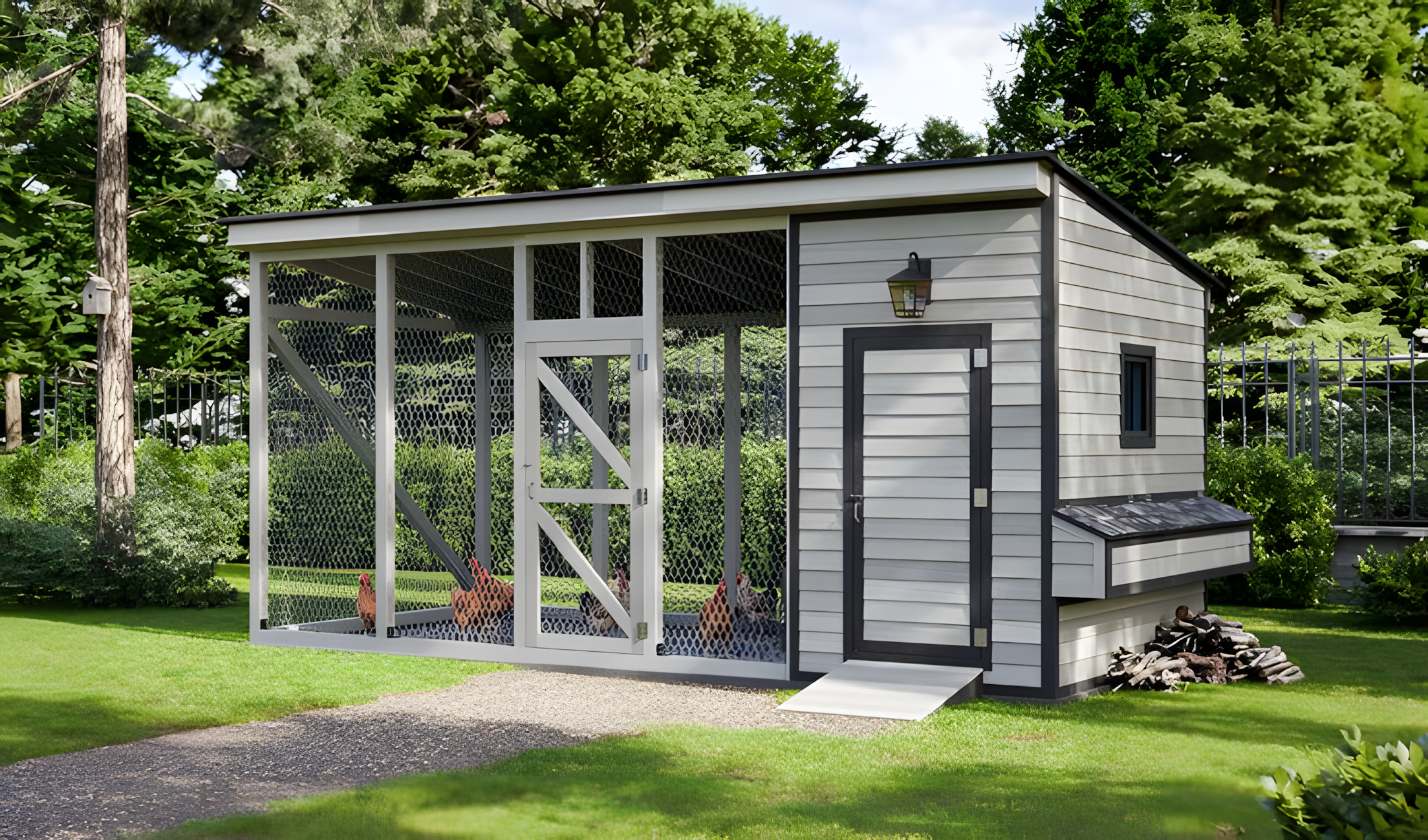By: Agriculture & DIY Architecture Desk
In a growing trend of sustainable backyard farming, homeowners are turning to well-designed chicken coops that combine style, security, and practicality. The image above showcases a modern chicken coop that blends seamlessly with the garden setting while offering chickens a safe, comfortable environment. Let’s break down its features, construction logic, and why this type of coop is becoming the standard for urban and suburban poultry keepers.
1. First Impressions – Design That Matches the Home
Unlike traditional rustic coops, this design uses:
- Horizontal siding panels painted in a light neutral color.
- Black trim framing around doors, windows, and roof edges for a sharp, modern contrast.
- A slanted shed roof to shed rainwater efficiently.
- A wall-mounted exterior lamp, giving the coop both functionality and curb appeal.
This ensures the coop looks more like a small garden outbuilding than a farm shed—ideal for residential neighborhoods where aesthetics matter.
2. Functional Zoning – Coop + Run Combination
The design smartly divides into two main sections:
A. Enclosed Coop (Right Side)
- Main entry door: A full-sized door allows easy access for cleaning and feeding.
- Side window: Provides ventilation and natural light inside.
- Nesting box attachment: A side-mounted nesting box with an exterior lid for egg collection.
- Elevated base: Slightly raised to avoid dampness and pests.
B. Wire-Mesh Run (Left Side)
- Tall wire fencing: Extends nearly full height, ensuring maximum protection against predators like raccoons or foxes.
- Walk-in gate: Human-sized door makes entry easy.
- Roof coverage: Protects chickens from rain and sun while still being open-air.
3. Step-by-Step Construction Logic
This type of coop follows a modular building sequence:
- Foundation & Floor
- Start with a leveled gravel or concrete base.
- Pressure-treated timber frame to prevent rot.
- Framing the Walls
- Use 2×4 studs spaced at 16″ intervals.
- Enclose coop walls with exterior siding panels.
- Leave openings for doors, windows, and nesting boxes.
- Installing the Roof
- Sloped design (shed roof) directs water backward.
- Metal or asphalt sheets provide durability.
- Attaching the Run
- Build a frame with vertical posts and horizontal beams.
- Stretch galvanized wire mesh (hardware cloth preferred over chicken wire).
- Reinforce mesh edges with staples and battens.
- Interior Setup
- Install roosting bars elevated above ground.
- Provide bedding material like straw or pine shavings.
- Add feeders and waterers in shaded zones.
- Nesting Boxes
- Each box approx. 12” x 12”.
- Exterior access hatch allows egg collection without disturbing hens.
4. Practical Advantages
- Predator Proofing: Full-height mesh walls and secure doors with latches.
- Ease of Cleaning: Walk-in design means no bending or crawling.
- Egg Collection: External nesting boxes simplify daily chores.
- Ventilation: Balanced airflow prevents moisture buildup, reducing risk of disease.
- Aesthetic Value: Blends with landscaping, so it doesn’t look out of place.
5. Who Is It For?
- Urban & suburban families keeping 6–12 hens for fresh eggs.
- Beginner chicken keepers who need a safe, low-maintenance coop.
- Sustainable households wanting a stylish yet practical farming structure.
6. Why This Coop Design Is Newsworthy
This modern coop design demonstrates how small-scale farming is adapting to urban living. It’s no longer just about functionality—it’s about combining livestock housing with modern architecture. By integrating thoughtful layouts, predator safety, and aesthetics, designs like this are reshaping the future of backyard farming.
✅ Bottom Line:
This coop is more than just a shelter—it’s a miniature farmhouse in your backyard. With its mix of modern design, safety features, and easy maintenance, it sets a new standard for how suburban chicken keeping can look and feel.
